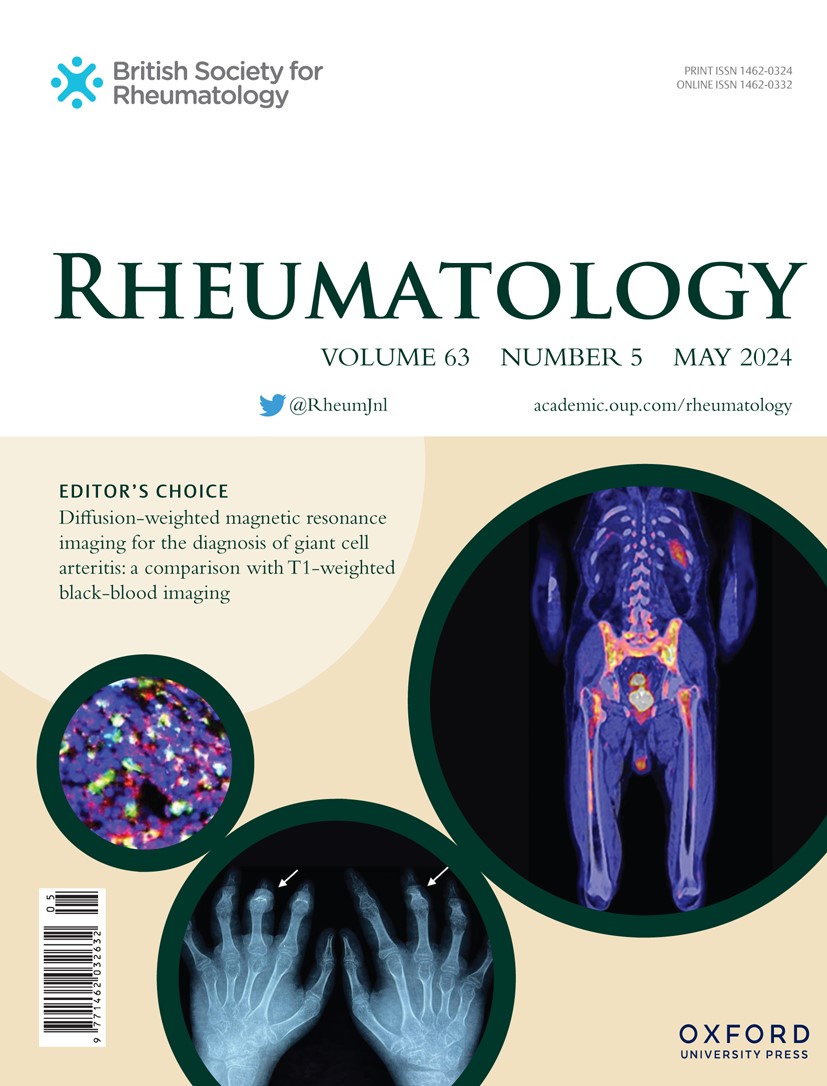无肌肉骨骼症状的银屑病患者队列的临床和超声特征:一项前瞻性和多中心研究
IF 4.7
2区 医学
Q1 RHEUMATOLOGY
引用次数: 0
摘要
目的探讨银屑病(PsO)无肌肉骨骼(MSK)症状且未进行全身治疗的患者银屑病关节炎(PsA)发展的临床和超声(US)特征。方法前瞻性研究,包括PsO患者,皮肤科医生随访。临床和美国数据由风湿病学家在基线和随访期间收集。结果共纳入78例PsO患者。平均病程15.1年(SD±13.4);大多数患者有轻度PsO(82%), 36例(39.7%)存在手指病,38例(48.7%)存在超重/肥胖。在美国的评估中,9名患者(11.5%)在关节处有功率多普勒1级,56.4%有钙化,30.4%有髋关节滑囊炎。60名患者完成了这项研究。中位随访76.60个月(IQR 39.34 ~ 85.25), 34例(56.6%)患者出现MSK症状。他们有更高的BMI (p = 0.013),腹部围(p = 0.022),疼痛(p = 0.047)和疲劳(p = 0.011)得分更高。他们的基线美国表现出更高的美国总分(p = 0.037)。5例(8.3%)出现MSK炎症症状,4例(5.5%)符合CASPAR标准。从基线到PsA诊断的平均时间为20.20个月(SD±12.02)。80%出现炎症症状的患者存在US滑囊炎(p = 0.049)。结论:在一组轻度PsO、全身性therapy-naïve且无MSK症状的患者中,PsA的发病率为每年1%。末端US滑囊炎与提示PsA症状的发展有关。出现MSK症状的患者在基线时具有较高的BMI,疲劳和疼痛VAS评分,并且可能构成向PsA过渡的高风险亚组。本文章由计算机程序翻译,如有差异,请以英文原文为准。
Clinical and ultrasound features of a cohort of psoriasis patients without musculoskeletal symptoms: a prospective and multicenter study
Objectives To evaluate clinical and ultrasound (US) features related to psoriatic arthritis (PsA) development in psoriasis (PsO), patients without musculoskeletal (MSK) symptoms and no systemic treatment. Methods Prospective study including PsO patients followed by dermatologists. Clinical, and US data were collected at baseline and during follow-up by rheumatologists. Results Seventy-eight patients with PsO were included. Mean disease duration was 15.1 years (SD ± 13.4); most had mild PsO (82%), onychopathy was present in 36 (39.7%) and overweight/obesity in 38 patients (48.7%). In the US evaluation, 9 patients (11.5%) had Power Doppler grade 1 at joints, 56.4% had calcifications and 30.4% bursitis at enthesis. Sixty patients completed the study. After a median of 76.60 months (IQR 39.34-85.25), 34 patients (56.6%) developed MSK symptoms. They had higher BMI (p = 0.013), abdominal circumference (p = 0.022), scored higher for pain (p = 0.047) and fatigue (p = 0.011). Their baseline US showed a higher total US score (p = 0.037). Five patients (8.3%) developed MSK inflammatory symptoms, and 4 met CASPAR criteria (5,5%). The mean time from baseline to PsA diagnosis was 20.20 months (SD ± 12.02). US bursitis was present in 80% of patients developing inflammatory symptoms (p = 0.049). Conclusions In a cohort of patients with mild PsO, systemic therapy-naïve and no MSK symptoms, incidence of PsA was 1% per year. US bursitis at enthesis was related to the development of symptoms suggestive of PsA. Patients who developed MSK symptoms had higher BMI, fatigue and pain VAS scores at baseline and could constitute a subgroup with higher risk for transition to PsA.
求助全文
通过发布文献求助,成功后即可免费获取论文全文。
去求助
来源期刊

Rheumatology
医学-风湿病学
CiteScore
9.40
自引率
7.30%
发文量
1091
审稿时长
2 months
期刊介绍:
Rheumatology strives to support research and discovery by publishing the highest quality original scientific papers with a focus on basic, clinical and translational research. The journal’s subject areas cover a wide range of paediatric and adult rheumatological conditions from an international perspective. It is an official journal of the British Society for Rheumatology, published by Oxford University Press.
Rheumatology publishes original articles, reviews, editorials, guidelines, concise reports, meta-analyses, original case reports, clinical vignettes, letters and matters arising from published material. The journal takes pride in serving the global rheumatology community, with a focus on high societal impact in the form of podcasts, videos and extended social media presence, and utilizing metrics such as Altmetric. Keep up to date by following the journal on Twitter @RheumJnl.
 求助内容:
求助内容: 应助结果提醒方式:
应助结果提醒方式:


